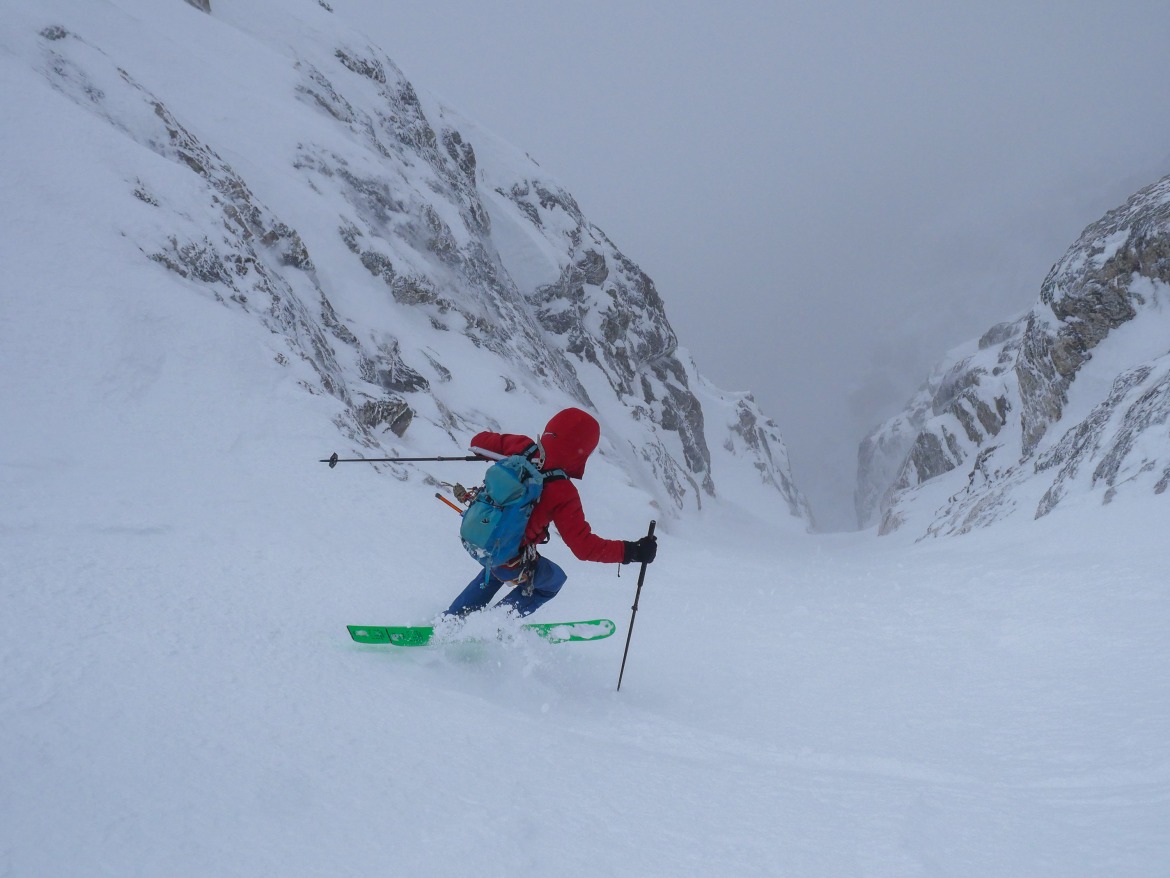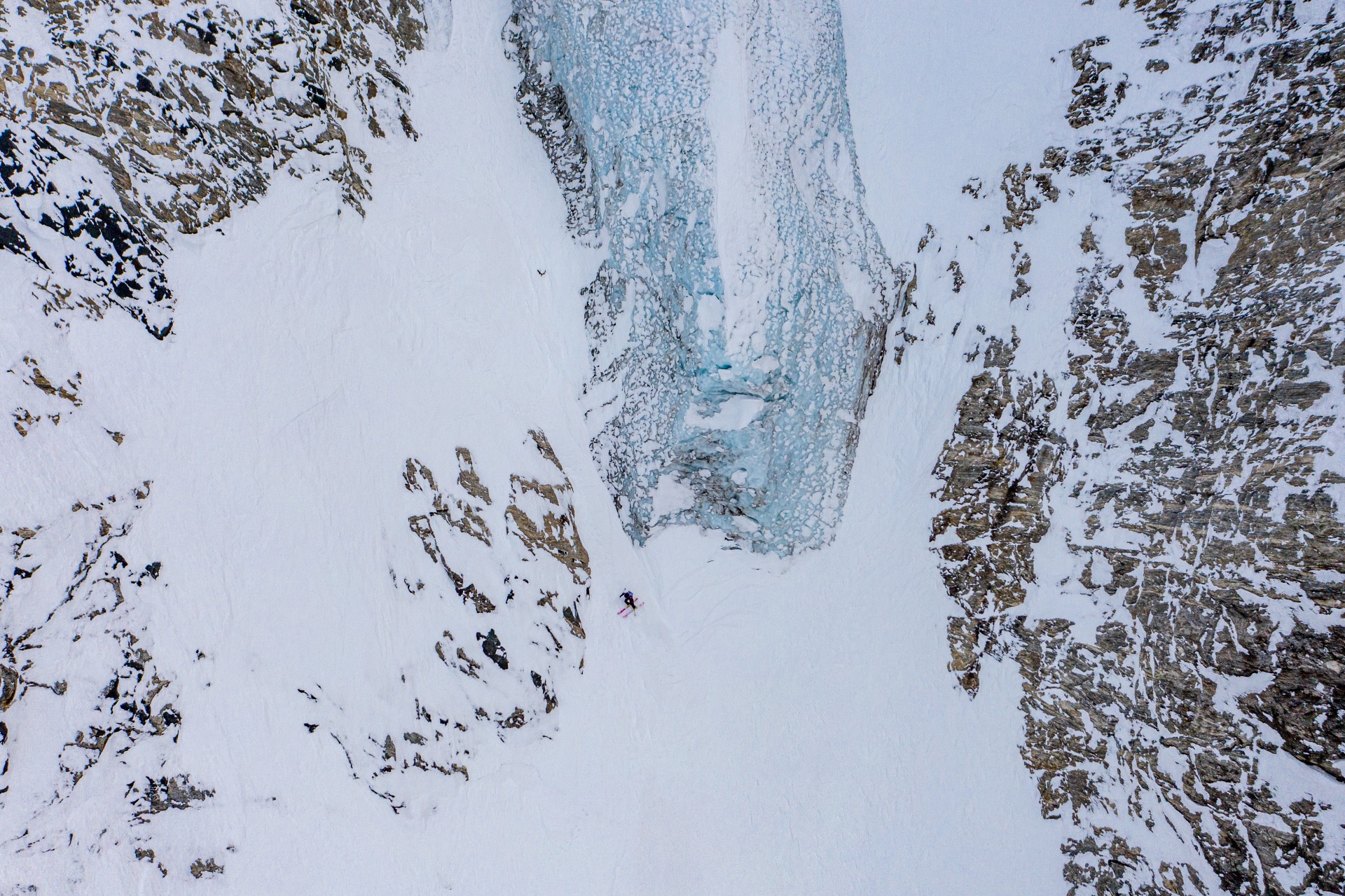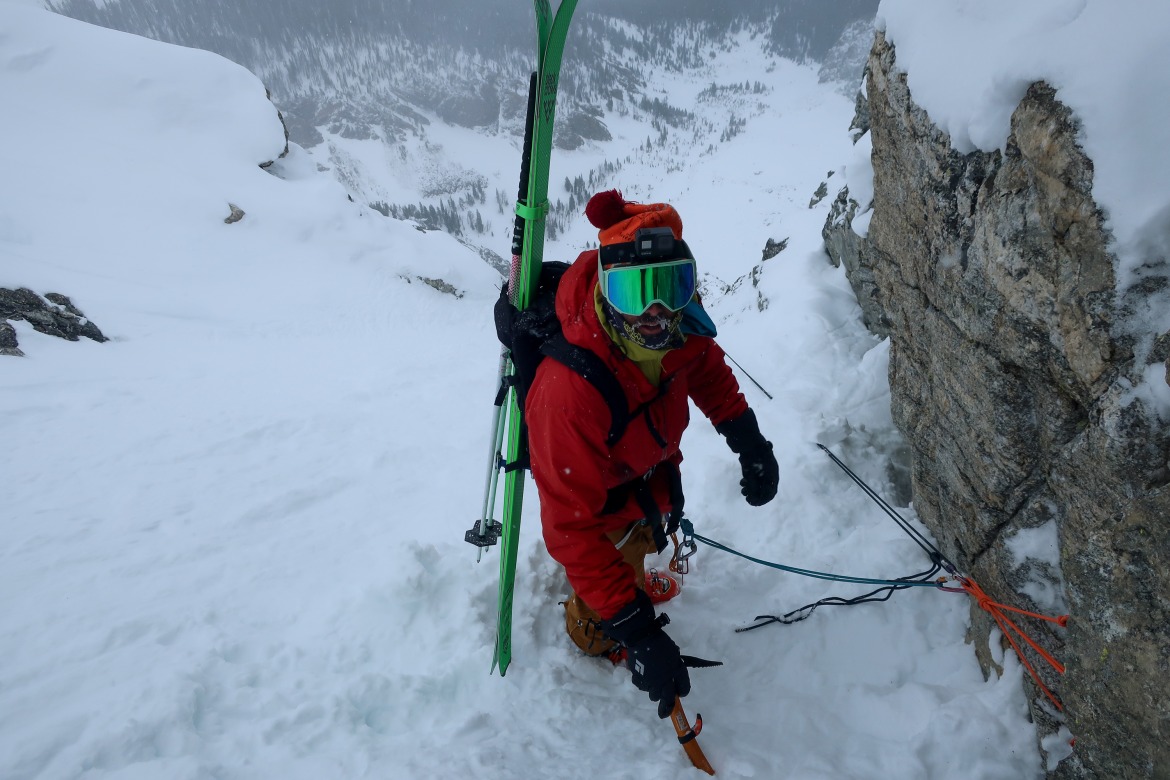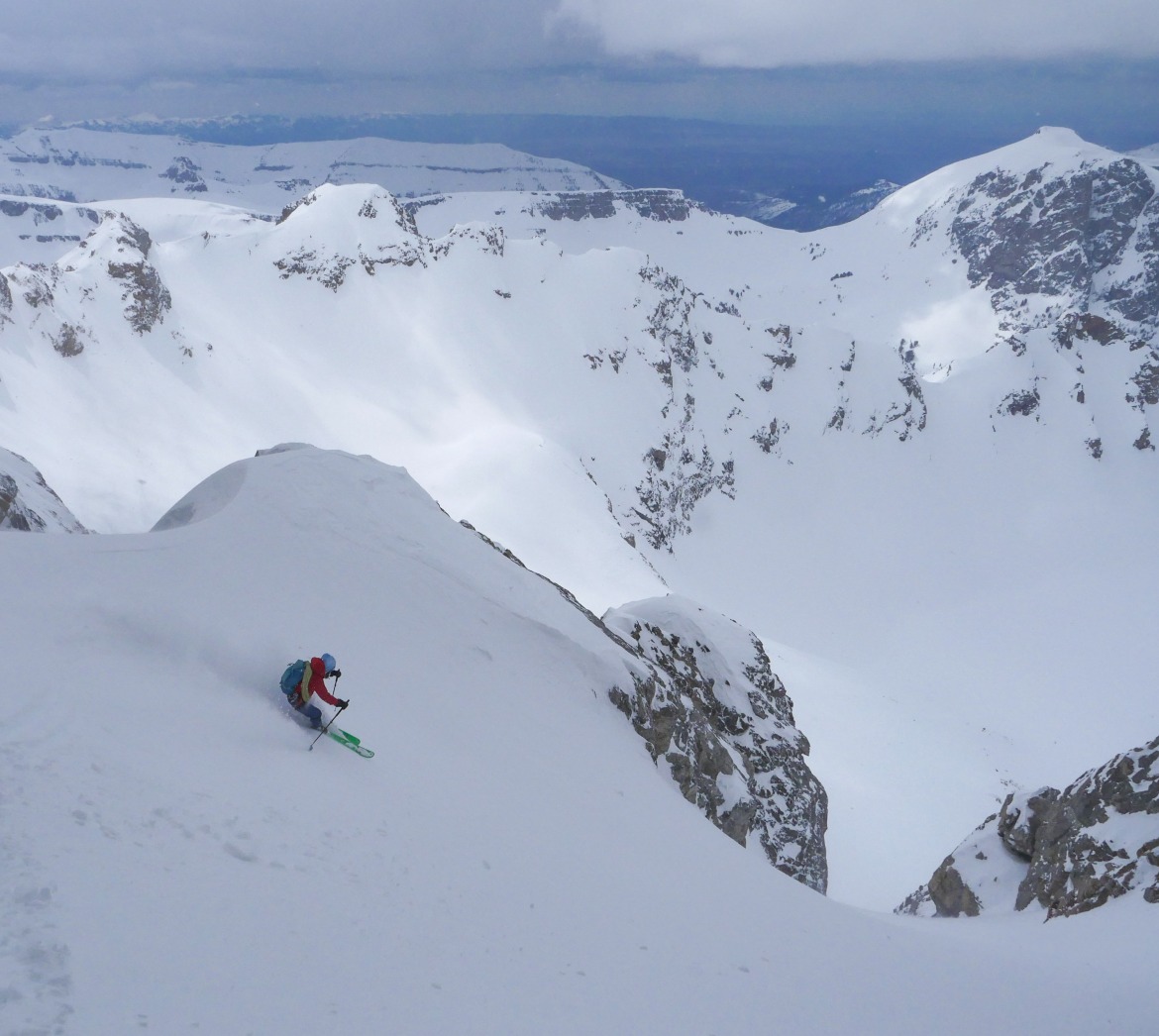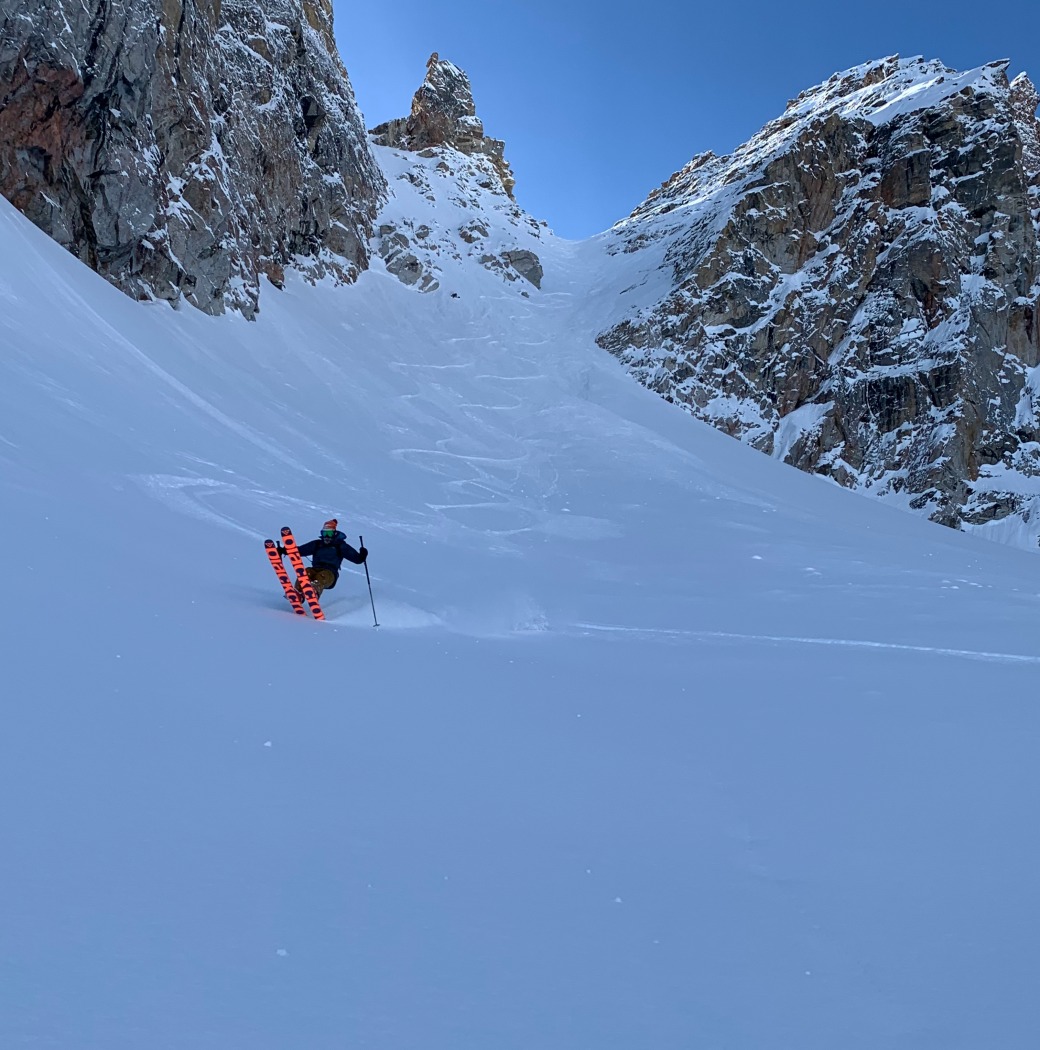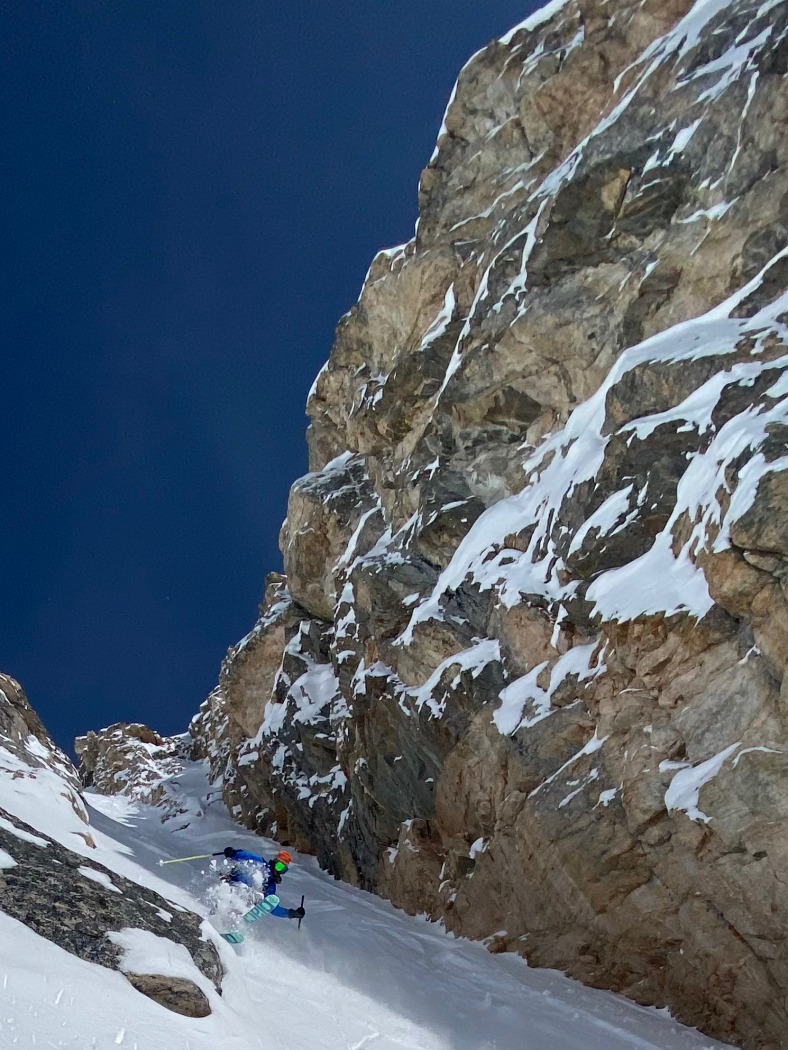Black Crows arrived on the freeride scene in 2006. With savvy marketing and an emphasis on building skiers’ skis, the Chamonix-based company spread its wings. Here’s a peak under the Black Crows’ hood with product lede Kenji Teshima and skiers Christina Lustenberger, and Adam Fabrikant.
This piece is part of a cooperative project with Black Crows.
There’s something about the ski industry that isn’t so different than other soul sports: early adopters of the cool seem to have a sixth sense for some trends. They are on the bandwagon before the rest of us — the early adopters. For anyone maybe 25 and older, that may seem like a classic narrative arc for trendy things. More often than not, those things ultimately evolve towards the not-so-trendy.
Still, it is interesting to see trends in ski design become fashionable and universally adopted and then passé and watch some of the cool kids, those early adopters, jump ship for the next thing.
That’s a timeworn product and marketing and cool kid cycle if there ever was one.
This too is a timeworn cycle — solid design and manufacturing and, of course, sweet performance. Embrace those three, and it’s likely the product will stick around. Skis are like that too.
Chamonix-based Black Crows took that arc. As far as brands go, the company’s soul remains. The sassy statements on the sidewalls remain; ski shaper Julien Regnier still features large in their ski-product videos. The topsheets? Bordering on iconic. And the skis? Hype or no hype; they still perform.
Here’s a qualifier before we go on and something we circle back to often; find what you like to ski. Stick with it. Try branching out when the ski’s pizzazz fades. Place importance on getting out and making turns.
To dig into the Black Crows’ scene, WildSnow reached out to Kenji Teshima, head of product development, to learn about the ski line. Skiers Christina Lustenberger (Revelstoke-based) and Adam Fabrikant (Teton based) meditate on the Black Crows skis in their respective quivers.
Design Principles with Kenji
WildSnow: Can you describe your role at Black Crows and how long you have been involved with the company?
Kenji Teshima: I’m head of product development team at Black Crows. I started 10 years ago in the company while we were only four employees, and we’re now more than 50.
At the beginning I used to work only on skis closely with our shaper Julien Régnier. My role is to make the ideas happen.
Today, the product has evolved, adding five more people, working on one hand in hardgoods (skis, poles, skins, bags), and on the other hand, softgoods (tech apparel, lifestyle apparel, headwear).
Our scope of work includes everything from the range definition to the end of the product’s life: briefing, design follow-up, material & product development, testing, and, finally, warranties.
WildSnow:Generally, can you discuss how the design philosophy for Black Crows touring skis evolved?
Kenji: I would say that generally, we think of Black Crows touring skis as focusing more on the descent than the ascent.
Of course, all our touring skis are designed with weight in mind. But we don’t want to make a compromise on the pleasure & performance on the downhill. Our goal is to design skis that can perform in any terrain and snow conditions. That’s our first priority.
Afterward, there are different types of skiers: some want a ski to go for a multiday adventure, and some want to climb 500-1000 meters for a powder run. We have large line of skis to cover all the needs and all types of skiers: but still with downhill performance in mind.
WildSnow: I’m curious, in your internal discussions, how often do you all debate the merits of a heavier v lighter touring ski?
Kenji: Generally speaking, heavier skis will always perform better on the descent than lighter skis.
But on the other hand, if a touring ski is too heavy, you’ll not tour very far away. It’s the right balance to find. For every new model, we look at the needs of the end consumer, but also the market & the competitors. For each type of ski, there’s a psychological weight barrier not to go over.
WildSnow: When working specifically with Black Crows’ athletes, what type of input do you seek from them?
Kenji: Mostly we ask about what they need, what they think of current models in terms of skiability, and what they miss. It’s our job afterward to translate those needs into design, shape & construction.
One major point is that we take feedback from athletes but don’t build specific skis only for them. The skis they have under feet at the end are exactly the same as we sell to the end consumers.
WildSnow: Can you describe in general terms the build process for the Freebird line of skis?
Kenji: In the early years of Black Crows, we shared the molds between resort skis & touring skis for production efficiency. Only the material construction was changing. Our touring skis were performing well, but they were not built optimally to save weight compared to the market. At that time, it was also a crazy race to the lightness.
Year after year, with growing quantities, we were able to build proper shape & construction dedicated to touring. It’s important to keep in mind, on the one hand, the combos skis/ bindings/ski boots that we use and, on the other hand, the fitness after skinning up because, in the end, you don’t ski the same way as alpine skiing.
We now have seven models in the Freebird touring range, from 80mm to 110mm underfoot. We cover more or less all the needs from fast touring to fat touring, including multiday touring & mountain touring, from skiers with an alpine background to younger freeskiers.
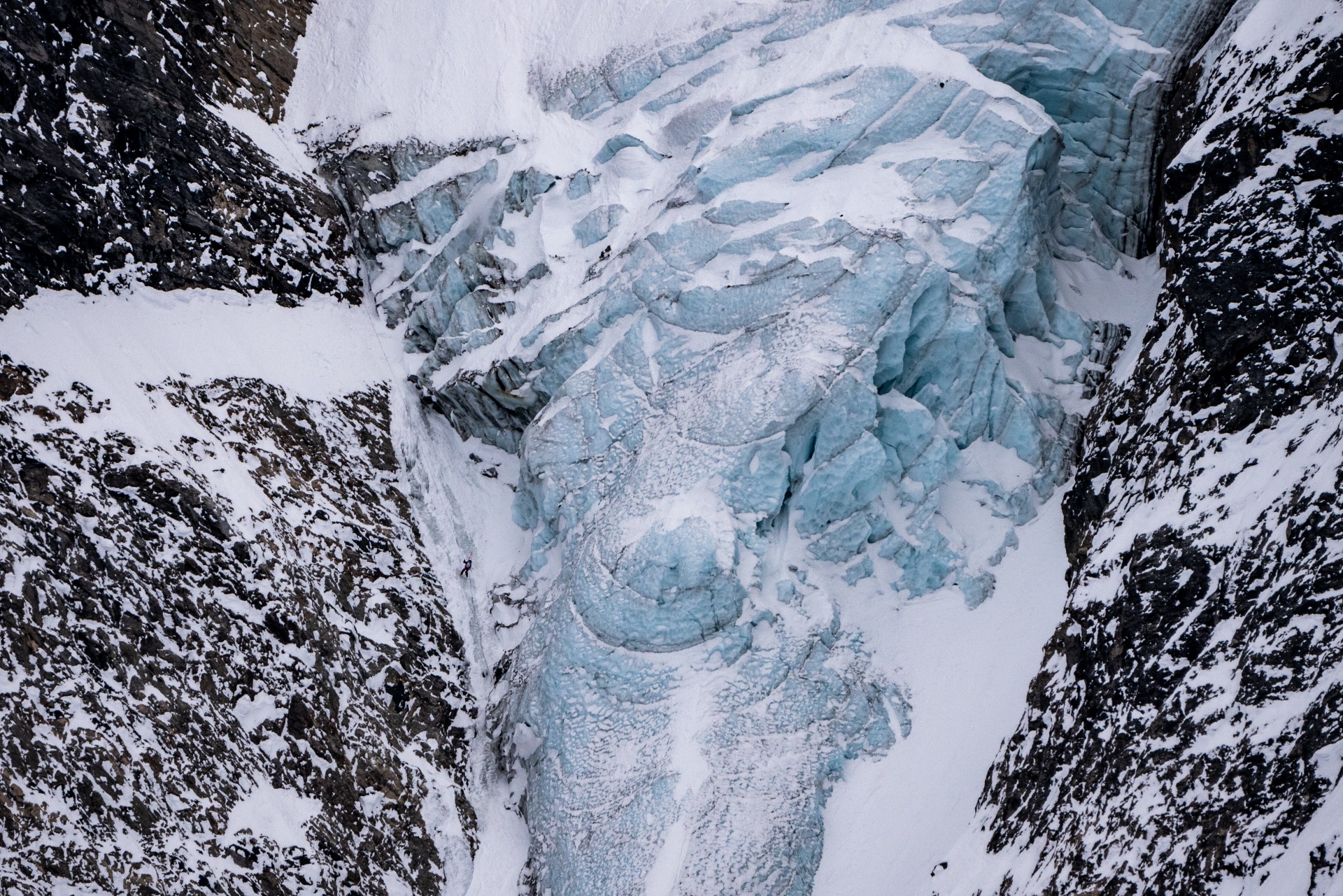
On rappel: Christina Lustenberger raps past and beyond a serac on the Gold Card Couloir. Photo: Steve Shannon.
Christina Lustenberger
Christina Lustenberger is an ACMG ski guide and describes her skiing as big-mountain steep-ski freeride-mountaineering skiing. Take that in. She’s a noted first descensionist, and a former alpine World Cup racer.
Go to bindings: Dynafit Superlite 150
I choose a pretty lightweight binding. Mainly because the Animas and Atris, they’re in their big mountain line; they’re not light skis. They’re not building it necessarily for ascending. These are skier’s skis, and you’ll see that a lot with Black Crows. They’re not really into sacrificing the build of the ski to make it light. My style of skiing is all human-powered. The ascents are huge here, and there’s a ton of walking and valley slogging. So I’ve tried to take the skier’s ski and have a lighter binding, which seems to work.
Go to boot: Tecnica Zero G Tour Pro
Atris Birdie
I’ll start with my go-to, the one ski that does everything. If I had to have one Black Crow ski, it would be the Atris Birdie. I’ve found it to be extremely versatile. It still carries a freeride element to the style of skiing and the style of turning I like to do in the mountains.
It works as a steep-ski ski-mountaineering ski too. And around interior British Columbia, my style of skiing is big-mountain steep-ski freeride mountaineering skiing. I like to add that freeride part because I’m not out there wiggling small turns; I’m seeking big unskied lines but in good conditions and good style in as big and fast of turns as I can, but appropriate to the conditions. That’s my go-to ski.
When I dip into ski, alpinism, that’s when I would be more in the Freebird line of skis. But usually, like last year, when we went to Baffin Island, I hemmed and hawed as to what ski I should take up there. During some years, it’s just boilerplate and super hard chalky couloirs. But last year, we lucked out and had insane powder snow in these epic 1000-meter lines.
And that Atris ski was absolutely perfect. I wouldn’t have wanted to take any other ski there.
After that trip, I went to the Alps and did a project there. We were skiing a steep south-fluted ice face that was borderline sketchy as to how extremely icy it was. And I was still on the Atris. It worked well, and at that time, Black Crows bumped the ski down to 105 underfoot from 107. But still, you lean it over on an ice face, and you have a really good connection to the edge, and I was able to jump turn really nice turns. I trusted that ski.
Atris Birdie Stats 178cm
Dimensions: 138 – 105 – 122
Radius: 20m
Weight: 1950g
Shape: Double rocker, medium camber
Construction: Poplar / Fiberglass, ABS sidewwalls, and semi cap construction
Anima Birdie
From there, I go towards the Anima Birdie. If conditions are like last year when we had a ton of deep snow in Revelstoke, I found that I needed just a little more ski width for storm skiing or skiing in the alpine. That’s when I would transfer to that ski: when the conditions are deeper and I want to float more and want something a little more playful.
Sometimes when I go to the Anima, initially, I’m like, “Oh, this ski is heavy.” But after three days, you forget about it, and it just becomes the new normal. You simply put yourself in a good boot, and you’re not going to sacrifice on the descent. And that’s what we’re all out there for; you don’t want to spend all day ascending a line and then feel wobbly coming down. You want to trust your gear.
There are so many skis that I haven’t dipped into. You talk to someone like Liv Sansoz in Chamonix, and all those girls, they have probably tried all the narrow Freebird skis: stuff that I wouldn’t even consider using in Revelstoke. In contrast, they never, except maybe a few days in the winter, get on the Anima; they think it is extremely wide. But, here in Revelstoke, we’re so fortunate, usually, to be able to ski big lines and deep enough snow that you’re considering a 115 underfoot.
Anima Birdie Stats 176cm
Dimensions: 144 – 115 – 134
Radius: 19m
Weight: 2150g
Shape: Double rocker, lower camber
Construction: Poplar / Fiberglass, carbon – kevlar tape laminate, ABS sidewalls, and semi cap construction
Enter the Camox Freeebird
Most of my skis are all around 178cm. The Atris would be the center or middle ski, and I swing to the Anima for deeper conditions, usually until February, and then maybe play on the Atris again. But anytime I’m going to terrain where I may be climbing mixed ground or ice pitches, I take the Camox Freebird. If we are pitching out water ice, or a pitch of mixed rock climbing, or a few technical steps, it’s always nice to have something much lighter on my back when ascending that type of terrain. I also don’t want a wimpy ski — I want a ski that I can kick turn, or jump turn fast. I find the Camox Freebird is a good for all of that stuff.
Camox Freeebird Stats 178
Dimensions: 136 – 95 – 114
Radius: 17m
Weight: 1475g
Shape: Progressive front rocker and light rear rocker, medium camber
Construction: Paulownia, mix of glass / carbon fiber, titanal binding plate, ABS sidewalls except tip, and semi cap construction
Corvus Freebird
One of the lines I took the Black Crows Corvus Freebird on was the Gold Card Couloir that we skied in the Monashee Mountains — we skied it at the end of January. We had very winter conditions. I still wanted a winter-time wide ski, but the line was extremely steep and committing, so I wanted something stiff while I was on edge or committing to a jump turn. I needed that stiffness, something that wasn’t going to wobble because the upper face of that was probably 50-degrees steep. For a couple of 100 meters, the line descends over a huge glacial serac; below that, there was still a committing exit couloir. But the snow was wintery. Often when you think about ski-mountaineering, I think many people think of springtime and using a narrow ski. But many of my descents are done in winter, so having a wider ski is important.
Corvus Freebird Stats 176cm
Dimensions: 139 – 107 – 119
Radius: 21m
Weight: 1825g
Shape: Progressive front rocker and light rear rocker, classic camber (think wide/stiff ski mountaineering ski)
Construction: Poplar, mix of glass / carbon fiber, titanal binding plate, ABS sidewalls, and semi cap construction
Adam Fabrikant
Adam Fabrikant lives at the base of the Tetons, where his understated demeanor contrasts his big and bold ski objectives. He’s the type of person you could listen to for hours discussing his intimate ski knowledge of the Tetons and the Central Alaska Range.
He’s also an Exum Guide in winter and guides in the Alaska Range come spring. To learn more about his first descents, mine the Internet, read the American Alpine Journal, and keep an ear to the ground in the Tetons. Hint: don’t bother with Instagram.
Go to Binding: Dynafit Expedition
Go to Boot: Tecnica Zero G Tour Pro
Here in the Tetons, I think of my skiing mostly as powder mountaineering. That’s a term that we use a little bit out here. Getting up is non-technical, so the ascents are not super complex, mainly just long approaches and big climbs. We can get on top of the peaks.
As far as my style, I’m not a free rider by any means. I’m not skiing a million miles an hour and trying to go as fast as possible. I’m also not trying to go as light and fast as possible, like with rando-race style gear. I’m inspired by some of the free riders and what they’re doing in the Alps; skiing fast on big lines. And I’m also inspired by the Killans out there, just moving fast in the mountains, and finding a middle ground in our wilderness style skiing that we do here in the US, whether it’s in the Northwest, the Tetons, in the broader Rockies, and bringing that up to Alaska as well.
For myself, more recently, I have liked combining climbing and skiing. I think that’s really fun. But the reality is, I’m not doing that 99% of the time. Today, for example, I just went powder skiing; it was a simple and classic ski tour. That said, when traveling and choosing objectives in places like Alaska, I enjoy the technical nature of the terrain. I’d say up there, I’m even further away from free riding, and I’m skiing in a style that’s slower, more conservative, more about control, but more about bringing endurance and technicality on the way up and down, in a higher level of uncertainty.
And you hear the word uncertainty and think of risk. But it’s more about asking if we can do this in good style. Can we ski all of it…100% of the mountain? Can we do it in a light and fast style that we respect and appreciate? And physically, can I pull this off?
I look at ski objectives in this way. Because obviously, you can always get out the ropes, build anchors, rappel everything; you have got to do whatever you have to do to keep it safe. But if I choose something, it will be challenging for us to bring it all together. I don’t want to go do something where I know it is in the bag. I’m inspired by what the limits are in some ways.
But coming full circle, that’s not what we’re doing most of the time.
The Navis Freebird- the “green” ski
The green ski, the Black Crows Navis Freebird, is my go-to high-mountain ski when I want a precision tool. I’ve gone through three or four pairs and always put the Dynafit Expedition binding on them. Without sounding too corny, it’s always been my expedition ski, and that binding is pretty rock solid.
As much as I love that ski, it’s an amazing tool for precise moves on firm snow — classic ski mountaineering terrain; hop turns. I don’t love it mid-winter in the Tetons. That’s when I’m skiing a 4000 to 5000-foot run, and if there’s 1000 feet of technical skiing and 3000 feet of more moderate terrain, I’m going to choose a more playful ski.
The Navis Freebird is so good in funky snow and the steep skiing style I enjoy; it also makes them less fun and playful in powder, on the aprons, and in the rest of the egress.
In terms of sizing, I’m 5’8″ and usually run a 173cm Navis.
In the Navis Freebird, that might be a little short for most skiers my height and weight. But with this ski, and for myself, I’m a 100% human-powered skier. So I like shorter skis just for going uphill. Depending on the season, once March or April arrives, that’s the ski I reach for in the Teton Range. When I go up to Alaska, I also think of the green ski for objectives on Denali, Foraker, and Hunter.
And for the type of skiing I do when I travel, typically, that’s what I bring; for most of my ski mountaineering expedition stuff, it’s a great tool.
Navis Freebird Stats 173cm
Dimensions: 138 – 102 – 118
Radius: 19m
Weight: 1625g
Shape: Progressive front rocker and light rear rocker, classic camber
Construction: Paulownia /Poplar/ Paulownia, mix of glass / carbon fiber, titanal binding plate, ABS sidewalls, and semi cap construction
The Nocta
I think I might do the most days on the Black Crows Nocta, which is 122mm underfoot — that’s a pretty big ski, and I’m skiing a 177cm, a relatively shorter size.
I have two pairs of Noctas right now; an older pair that is getting retired, I have Dynafit Superlite bindings on those, and then I put a Plum Pika on the other pair just because I’ve broken Superlites and wanted to try something different. These are also paired with the Tecnica boots.
I work as a full-time ski guide for most of the winter in the Tetons. We have a lot of days with considerable or higher avalanche hazard, so we’re skiing relatively low-angle slopes and in deep snow. That combination makes me enjoy having a big ski.
It’s relatively lightweight snow, we’re not skiing PNW-style snow, but we’re also not in full Wasatch-style snow. With our heavier snow, having these bigger skis is a good combo. I’ve skied off the summit of the Grand Teton on the Nocta and I’ve done some pretty absurd ski mountaineering on that ski as well since they’re fully rockered and pivot on a dime.
We started a little joke last year because it was a pretty crummy winter snow-wise: they’re a great bad snow ski, which sounds silly, but you can deal with facets and weird crust layers and wind effect a little bit better. So I do enjoy that tool quite a bit. For most of the winter, that’s what I’m grabbing.
When I went on my first Denali trip, I was on a pair of Dynafits that were maybe 86mm underfoot. And then, I moved to Utah. The culture there in the Wasatch was very light and fast. I was in TLT 5s, and mainly Dynafit and Black Diamond skis because they were inexpensive and light.
When I moved to the Tetons, I found the culture quite different. There’s not as much, I won’t say rando culture, but just that light and fast ethos. Primarily you’re doing one, two, maybe three descents in a day here. It’s just bigger climbs and bigger ski descents. So the transitions aren’t as much of the day. I have been influenced by the Teton mentality of hauling bigger, heavier gear.
The Nocta Stats 177cm
Dimensions: 139 – 122 – 132
Radius: 21m
Weight: 1925g
Shape: Reverse camber
Construction: Paulownia /Poplar/ Paulownia, fiberglass, ABS sidewalls, and semi cap construction
The Atris
I don’t have the scales out, but I think the Black Crows Atris is lighter than the “pink ski,” the Corvus Freebird. Technically, the Atris is not in the touring lineup, but Black Crows is not super North American influenced in their weights.
Again, I don’t ski super fast, and I’m also not a super powerful skier. But I end up using the Atris a lot because it’s between the Navis Freebird (102mm) and the Nocta (122mm) for width; weight-wise, it’s also between those two.
The Atris is a little lighter than the Nocta, but not by worlds. By mid-winter, when I’m going to ski something technical, but I don’t want the green ski because I’m powder skiing most of the terrain, I take the Atris. I’m not taking the Nocta because it seems silly and the incorrect tool.
Here in the Tetons, for example, we have this area called Death Canyon, where there are lines called the Apocalypse and the Son of Apocalypse, and the Mayan Apocalypse; all these gnarly technical couloirs. Most of the time I go in there, I bring the Atris.
In those situations, my turns are more controlled and precise. But, even if I’m linking and flowing through sections, I’m still not going fast.
I did ski the Nocta in 20 inches of snow there, which was pretty unreal. But I want to avoid hitting ice with the Nocta. And the reality is most of my winter days are guiding. So I am trying to ski in control, keep it together and model it a little bit. The Atris fits that category for me.
I’ve also skied the Grand, Middle, and South in a single push, [the Teton Trifecta], on the Atris before, so I’ve used it with big linkups just because they ski well.
It was interesting. A partner and I were doing that traverse a few years ago in January, and it had been a pretty good winter, so we’re talking mid-winter conditions. A friend was doing the Middle and South linkup. On top of the South, we ran into them; they were on the green skis. I showed up on the Atris. It was the end of the day, and everyone was tired. We’re going to ski off the South Teton, which is now the majority of our vertical for the day, taking it to the valley floor.
So my partner was on the green ski too, and I was on the Atris. I started powering through some of the more challenging snow, and both ended up buying the Atris that week.
They’re definitely not the tool I would use to ski something super firm. But for something in the middle, where I don’t want to ski the Navis Freebird, they still ski powder well, and they’re a super playful ski.
The longer I’ve lived here, the more, in my mind, I’ve turned into a free rider. I’m not skiing that fast or jumping off impressive things. But the Atris allows me to see and have that feeling more, which is fun. It’s quite forgiving compared to the pink ski. It’s significantly softer, but can still hold an edge and rail.
The Atris Stats 178cm
Dimensions: 138 – 105 – 122
Radius: 19m
Weight: 1950g
Shape: Double rocker, medium camber
Construction: Poplar / Fiberglass, ABS sidewwalls, and semi cap construction
Jason Albert comes to WildSnow from Bend, Oregon. After growing up on the East Coast, he migrated from Montana to Colorado and settled in Oregon. Simple pleasures are quiet and long days touring. His gray hair might stem from his first Grand Traverse in 2000 when rented leather boots and 210cm skis were not the speed weapons he had hoped for. Jason survived the transition from free-heel kool-aid drinker to faster and lighter (think AT), and safer, are better.

